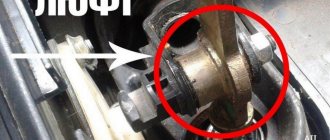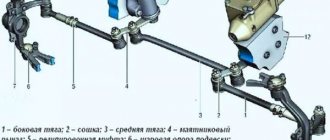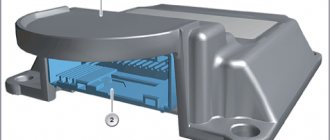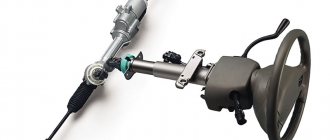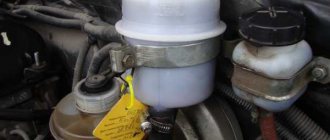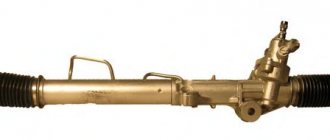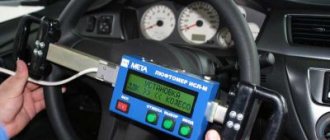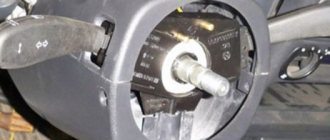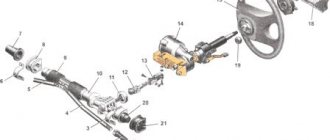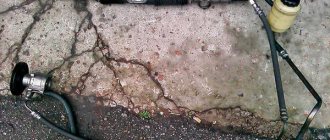Now almost every modern car is equipped with hydraulic power steering. The main task of this mechanism is to create additional force on the steering elements to make it easier to turn the wheels during maneuvering.
Initially, the hydraulic booster was installed exclusively on trucks and agricultural equipment for one simple reason - without this mechanism it is very difficult to drive a truck or tractor. But over time, power steering began to appear on passenger cars.
At low speeds and when parking, the driver of a car without power steering has to make significant efforts to turn the steered wheels, but at high speeds the resistance decreases, that is, the effort on the part of the driver to perform the maneuver is reduced.
The amplifier provides the same force that the driver must apply, both at low and high speeds. Therefore, parking and maneuvering when starting to move with power steering is much easier.
The hydraulic booster not only increases travel comfort but also further increases safety, since it allows you to keep the car on the road if a tire breaks at speed.
Also, the presence of power steering on the steering mechanism allows you to reduce the gear ratio. That is, the number of steering wheel revolutions decreases.
Location of parts and composition of the hydraulic power steering
The hydraulic pump is located near the crankshaft pulley and is connected to it by a drive belt. Depending on the design of the vehicle, the same drive can drive the generator shaft and pump. The control valve, also known as the distributor, is built into the steering shaft mechanism and responds to turns of the steering wheel in one direction or another, thanks to a special device - a torsion bar.
The location of the hydraulic cylinder depends on the type of steering mechanism. In most cars, it is built into the rack and is a piston that pushes it in the required direction. In cars with a worm drive steering wheel (the so-called steering column), the cylinder is a separate unit. Rods are connected to it, which are responsible for turning the front wheels.
These elements are combined into a single system by pipes that are designed for high pressure. The working fluid, oil, circulates through them. Its reserve is located in the expansion tank, which is installed at the highest point of the hydraulic system.
This reservoir for the working fluid contains a filter element and a dipstick for monitoring its level. With the help of oil, the rubbing pairs are lubricated by the mechanisms, plus forces are transferred from the pump to the hydraulic cylinder. The mesh in the tank serves as a filter from dirt and small metal shavings formed during operation.
If the expansion tank is made of translucent plastic, then the level of liquid in it can be checked by simple visual inspection. But if the plastic is opaque, or the tank is made of metal, then the level of the working fluid can be checked using a dipstick.
In some cars, it is possible to check the power steering fluid level only after briefly running the engine, or when turning the steering wheel several times in different directions while the engine is idling. There are special notches or marks on the dipstick (or on the expansion tank itself).
Major breakdowns
Since power steering is a mechanism, sooner or later it may break. Especially considering that he is constantly on the move. The frequency of breakdowns and their severity depends on the intensity of use of the hydraulic booster and its design. In practice, the following faults most often appear:
- the pump is noisy;
- the pump belt becomes loose or worn out;
- the filter element in the tank becomes clogged;
- the pump itself breaks down;
- the pump valve is clogged;
- insufficient viscosity of the filled liquid;
- the hydraulic system becomes clogged;
- depressurization;
- there is not enough liquid in the tank.
If one of the above malfunctions occurs, it becomes difficult to turn the steering wheel to one side, shocks are transmitted more strongly, and noise and vibration also appear.
Mechanism design
The hydraulic power steering wheel consists of several main elements that are connected to each other by oil lines. This
- a rotary pump driven by a belt drive from the crankshaft of the car engine;
- a hydraulic distributor that directs the force in the right directions;
- a hydraulic cylinder with a piston, which is rigidly connected (by rails or rods) to the steering mechanism;
- expansion tank with the necessary supply of hydraulic fluid (oil).
History of appearance
The very first power steering, which experts most often remember, appeared back in 1823, invented by Robert Gurney. For the first time, people started talking about a hydraulic power steering mechanism in the USSR back in 1950, and in 1958 it was first installed on a high-class car (premium by modern standards) ZIL-111. Most often, this car was used to transport top officials of the USSR state; comfort had to be appropriate.
Today, power steering can be found in any car, even the simplest basic configuration. Some cars may have electric power steering or hydraulic power steering, but conventional power steering remains the most common. As cars and their design changed, engineers refined the power steering, its design and characteristics. Let's take a closer look at the structure and operating principle of the mechanism.
Pump
The power steering pump is needed to ensure that the required pressure is maintained in the system and that oil is constantly circulated. It is installed on the engine cylinder block and operates from the crankshaft pulley using a drive belt.
In principle, the design of this pump can be of different types. However, in practice, vane pumps have become widespread. They are characterized by high efficiency and serious resistance to wear. The working mechanisms of this pump - a rotating rotor with blades - are housed in a metal casing. During rotation, the blades capture the working fluid and, under pressure, pump it into the hydraulic distributor, and then into the hydraulic cylinder.
Since the pump is driven by a crankshaft pulley, its performance and pressure directly depend on the engine speed. To maintain the pressure at the level required for normal operation (100-150 Bar), a special valve is used. This is a pneumatic or hydraulic throttle that operates automatically.
Hydraulic distributor
The hydraulic power steering distributor is mounted on the steering shaft or on the steering drive elements. Its purpose is to direct the flow of working fluid into the corresponding cavity of the hydraulic cylinder, or to return it to the expansion tank.
The main elements of the power steering distributor are a torsion bar, a rotary spool and a distributor shaft. A torsion bar is a thin springy metal rod that twists under the influence of torque. The spool and distributor shaft are two cylindrical parts with channels for fluid. They are inserted into each other. The spool is connected to the steering gear, and the distributor shaft is connected to the propeller shaft of the steering column, i.e. with steering wheel. The torsion bar is attached at one end to the distributor shaft, and its other end is inserted into the rotary spool.
The distributor can be axial (if its spool moves translationally) or rotary (when the spool rotates).
Power steering: from trucks to cars
Hydraulic power steering (Power Steering) is a unit hidden in the bowels of our cars that creates additional effort to turn the wheels, thereby helping us steer without straining our muscles.
Despite the fact that the use of these devices on passenger cars began around the end of the 50s of the last century, they were considered something exotic for many decades.
However, the history of power steering does not even go back to the 50s; it all started much earlier. Thus, the first patent for a device resembling the current power steering was received already in 1902.
The following years, marked by the rapid development of the automotive industry, determined the niche where the hydraulic booster felt best and was considered the most useful - trucks.
Hydraulic cylinder + connecting hoses
The hydraulic cylinder is built into the rack. It consists of a piston and a rod that moves the rack under the influence of working fluid pressure. High pressure connecting hoses ensure oil circulation between the distributor, hydraulic cylinder and pump. From the expansion tank to the pump, and from the distributor back to the expansion tank, oil flows through low pressure hoses.
Hydraulic cylinder + connecting hoses
The principle of operation of the hydraulic booster
The main feature of power steering is that the system is activated immediately after the car engine is started, since the hydraulic pump shaft rotates synchronously with the engine crankshaft. While the driver is not driving, the pressure generated in the oil lines is released into the expansion tank. The operating principle of hydraulic power steering is to convert the pressure of the working fluid created by the hydraulic pump into mechanical work performed by the piston of the hydraulic cylinder. The algorithm for the functioning of the power steering is as follows:
The working fluid is pumped through the system, and excess pressure is sent to the expansion tank until the driver begins to turn the steering wheel. When turning the steering wheel, the distributor torsion bar senses the direction of rotation, due to which one of the two valves is activated, which opens the flow of hydraulic fluid to the cylinder piston.
Oil on one side presses on the piston, forcing it to push the rack or rod in the desired direction until the driver stops turning the steering wheel. When the steering wheel stops in any position, the hydraulic distributor closes the valve and the piston stops pushing the rack.
When the steering wheel is rotated in the opposite direction, the first valve closes and the second one is immediately activated. The fluid enters the piston from the other side, causing it to move and push the rack in a different direction.
For example, a car is standing still with the engine running, and its wheels are set straight. In this position, the power steering does not work, and its fluid is simply pumped through the system - from the expansion tank to the hydraulic distributor and back.
The driver begins to rotate the steering wheel. The torque from the steering wheel is transmitted to the hydraulic distributor shaft and further to the torsion bar, which begins to twist. The rotary spool does not rotate at that moment, since friction does not allow it to do so. Moving relative to the spool, the distributor shaft opens a channel for oil to enter one of the cavities of the hydraulic cylinder (depending on where the driver turns the steering wheel). All working fluid is sent under pressure to the hydraulic cylinder. Oil from the second cavity of the hydraulic cylinder enters the drain line, and then into the expansion tank. It presses on the piston with the rod, due to which the steering rack moves and the wheels turn.
When the driver stops turning the steering wheel, but continues to hold it in the turned position, the steering rack, as it moves, rotates the rotary spool and aligns it with the hydraulic distributor shaft. At that moment, the distributor is placed in the neutral position, and the working fluid again simply begins to circulate idle through the system, without doing any work (as was the case when the car was standing still and its wheels were in a straight position).
Failures of the power steering mechanism on Priora: types of faults and methods for identifying defects
The quality of the fluid for the power steering system has a direct impact on the service life of the system. During the operation of the vehicle, the possibility of various malfunctions cannot be excluded. The most common breakdowns and symptoms on a Priora with a power steering system are:
- Noisy operation of the power steering pump.
- Leaks at the joints of hydraulic hoses.
- Steering wheel vibration.
- The need to exert greater effort to turn the wheels increases.
- There are jolts in the steering wheel, especially when turning.
- Makes it easier to turn the steering wheel at high speeds.
- Whistle when turning.
Interesting! The oil in the power steering reservoir should not be dark in color. If it has darkened, then it's time to change it.
All of the above signs indicate that the power steering mechanism needs diagnostics. It is better to immediately check the system, identify defects and eliminate them, than to wait until the power steering fails completely, which may lead to the possibility of an emergency.
Let's look at several types of power steering faults on Priora that car owners often encounter:
- The occurrence of shocks in the steering wheel. The reason for this phenomenon is the weakening of the drive belt. Over time, this element stretches, so its tension needs to be adjusted. The belt is tensioned on a Priora with power steering using a tensioner pulley. A detailed description of this process can be found here. The cause of shocks may also be a violation of the integrity of rubber hoses or metal tubes. There is a known problem of cracking in high and low pressure hoses (especially low-quality ones). The metal tube on the low pressure line is corroded. Over time, it rusts on all Priors, and therefore, closer to the mileage of 100 thousand, it needs to be changed. It is shown in the photo below.
- When you turn the steering wheel, the force increases. Typically, such a defect is associated with an insufficient amount of fluid in the system. If the level is normal, you should check the belt tension and condition. Remember the last time the oil was changed, and if necessary, replace it.
- Noise when the motor is running. This is another of the most common types of breakdowns on Priors with power steering. When starting the engine, a hum is detected in the generator area. Many people associate this defect with a malfunction of the generator, but it could also be the power steering pump. The pump uses a bearing that wears out over time and must be replaced. Many people recommend not disassembling the pump, but this mechanism is quite repairable. On Priora, the power steering pump uses bearing 6303 (303). It has parameters such as an internal diameter of 17 mm, an external diameter of 47 mm and a width of 14 mm. Moreover, it is recommended to choose products made in Poland or Japan.
- An oil leak from the oil pump is easy to detect, and repair of such a breakdown is carried out by replacing the oil seal. For power steering Priora, you need an oil seal marked ZF 0770-080-463 and dimensions 19x32x7 mm.
- Steering wheel vibrations occur when the system becomes airy. The cause of depressurization is a violation of the integrity of the connections. It is imperative to identify the cause of air getting into the system and eliminate it. After this, perform pumping.
Most often, problems with the power steering mechanism are directly related to the pump. It is this element that needs to be diagnosed, repaired or replaced. We will consider in detail below how to remove and replace the power steering pump on a Priora.
Diagram of operation of hydraulic power steering
If you turn the steering wheel all the way and at the same time increase engine speed by pressing the gas pedal, the pressure in the power steering circuit increases to maximum values. This can lead to leaking seals and even rupture of hoses. Therefore, manufacturers of cars with power steering do not recommend holding the steering wheel in the extreme position for more than five seconds.
If for some reason the car’s engine stalls, or the power steering itself breaks down and fails, the driver will still have full control over the front wheels of his car. Just to turn the steering wheel the driver will have to make some muscular efforts. Like good old times".
Pros and cons of power steering
There is no doubt that the advantages of a power steering system are much greater than the disadvantages. Otherwise, power steering would not have gained such universal popularity: after all, nowadays the vast majority of new cars from all leading automakers are equipped with it.
Reliability
The hydraulic power steering system is very reliable. It has been tested over many years of practice on various types of vehicles and shows almost flawless reliability.
Hydraulic power steering has the ability to develop serious power and overcome significant frictional resistance from the wheels. Therefore, it can be used on vehicles of any carrying capacity and overall dimensions.
Comfort
Comfort in driving a car for the driver is the main characteristic feature and main advantage of power steering. Power steering, in fact, was created precisely for this purpose - to significantly make it easier for a person to drive a car, to relieve him of the need to exert muscle effort when turning the steering wheel.
Fast reaction
Since the steering wheel rotates much more easily with power steering than without it, and fewer steering wheel revolutions are required, the driver has the opportunity to react more quickly and quickly to any rapid changes in the road situation.
Better precision and sharp handling
The possibilities provided by the use of hydraulic booster provide an additional bonus to all car manufacturers. Since the power steering actually performs the physical work of the driver instead of the driver, it has become possible to use steering mechanisms with a smaller gear ratio in the design of cars.
Among the disadvantages of hydraulic power steering, the following properties are noted.
In order not to cause damage to the power steering, the steering wheel should not be held in the extreme right or left position for a long time. Especially at higher engine speeds. In this case, due to the formation of critically strong pressure, the oil can squeeze out the seals and leak out.
The hydraulic pump drive device is designed in such a way that it functions continuously together with the car engine. Because of this, the pump wears out faster and takes away some of the engine’s energy, albeit slightly, but still increasing fuel consumption.
All elements of the power steering system require periodic maintenance, and it is also necessary to monitor the level of hydraulic fluid in its expansion tank.
Power steering systems on economy-class cars and cars of budget price categories make the steering wheels less informative when driving at high speeds. Only in expensive cars is a special device implemented for the power steering pump, which allows the oil pressure in the system to be reduced as the speed of the power unit increases. At the same time, the steering wheel seems to be “filled” with some heaviness, and the feeling of “emptiness” does not arise when driving the car at significant speeds.
Power steering requirements
To ensure maximum comfort, modern engineers place the following requirements on the hydraulic booster:
- device reliability;
- silent operation;
- ease of maintenance and modest overall dimensions;
- the ability to control the machine if the power steering fails;
- high environmental safety and manufacturability;
- smoothness and ease of steering wheel control;
- small turning moment and the presence of a neutral position;
- providing force and kinematic tracking action.
What is provided for by the power steering service rules
To ensure uninterrupted operation of the power steering, it is necessary to periodically perform the following maintenance and service operations:
monitor the level and condition of the power steering fluid in the expansion tank;
from time to time inspect the pipes and fittings of the system: whether cracking or oil leaks have appeared;
replace the hydraulic fluid in accordance with the interval specified in the operating and repair instructions;
pay attention to the appearance of extraneous noise, indicating serious wear of the hydraulic pump bearings;
change a worn-out power steering drive belt in a timely manner so that it does not break at the most inopportune moment - somewhere on a long journey. If there are shocks and blows to the steering wheel, then this is a characteristic sign of a stretched, worn hydraulic pump drive belt. When the belt slips, the pump begins to operate jerkily, and oil enters the system with a clearly visible pulsation.
How often should you change the power steering fluid?
Experts say that the technical fluid in the hydraulic booster can be used throughout the entire period of operation of the vehicle. In this case, the oil needs to be changed periodically. The period depends on how intensively the owner uses his car. If a car runs about 10,000-20,000 kilometers a year, then the oil needs to be changed every 24-36 months. It is worth recalling that as a result of power steering operation, its elements begin to heat up. This leads to an increase in oil temperature, which worsens its properties. The fluid should be changed if a burning smell appears or if foreign particles are present. In total, about 1.5 liters of oil are poured into the hydraulic booster. Two levels are measured - hot and cold. In the first case, the oil temperature ranges from 50 to 80 degrees, in the second - from 0 to 30 degrees.
Author: P. Afanasyev

